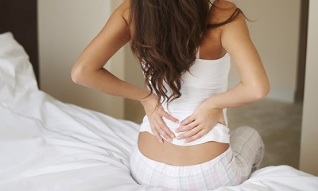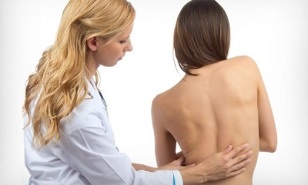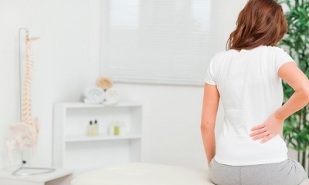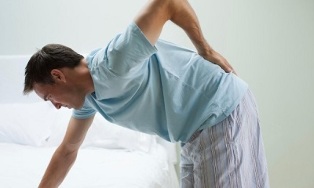
Low back pain is a symptom that can be associated with a variety of medical conditions. They can be permanent or periodic, local or generalized.
If a person has pain in the lumbar spine, a comprehensive examination is prescribed to determine its cause.
Possible causes of low back pain and their characteristics
Low back pain can be caused by a variety of reasons, depending on the severity of the discomfort. Pain syndrome reduces a person's quality of life, limits mobility and makes it impossible to perform daily tasks.
There are many causes of back pain in the lumbar region. Some of them are quite serious and require urgent specialist intervention.
Lumbar sciatica
Lumbar sciatica is a disease of the musculoskeletal system, in which there is compression and inflammation of the spinal root. This pathology is of a secondary nature, because it develops in the background of degenerative processes of the musculoskeletal system.
Common symptoms in this case are:
- Pain syndrome, aggravated by sudden movements, lifting weights. The location of the pain depends on the degree of damage. The syndrome can affect the lumbar and gluteal region, the back or front of the thigh. If there is damage to the nerve endings under the first and second lumbar discs, then the patient has lumbago in the lumbar region and buttocks.
- Increased pain when coughing, sneezing.
- Inability to stay in one position for a long time.
- Mobility disorders: inability to tilt the torso freely forward, backward or sideways, inability to bend the fingers of the lower extremities.
In lumbar spine radiculitis, the pain usually appears suddenly, stops spontaneously. The next time the pain becomes sharper, more pronounced.
Osteoporosis
Osteoporosis of the spine is a phenomenon in which the process of leaching calcium from the bones occurs and the activity of the cells responsible for bone growth is disturbed. In such conditions, the bones are quickly destroyed, their density is constantly decreasing. Osteoporosis is difficult to suspect in the early stages of development.
Most often the patient feels sharp pain in the lumbar region at a time of strong tension - with a sudden turning of the body, falling, lifting weights.
In addition to severe pain in the lower back, osteoporosis has such manifestations as:
- chronic murder;
- bulging abdomen;
- impaired spinal mobility.
Compression fracture, caused by osteoporosis of the lumbar spine, causes acute pain, which is increased by palpation of the affected area, as well as muscle spasm.
Scoliosis

In lumbar spine scoliosis, its structures deviate to the right or left. These changes are reflected in the condition of the surrounding tissues: they become irritated, and foci of inflammation appear in the musculoskeletal structures.
Left scoliosis is most commonly diagnosed. In left-handed people, scoliosis develops on the right side.
In the initial stage, lumbar spine scoliosis may not appear in any way. Negative changes can be followed only by the results of X-ray examination.
Characteristic symptoms in this case, with severe pain in the lumbar spine, are:
- saginjanje;
- swelling in the lumbar region;
- chest pain;
- displacement of the pelvic girdle, causing one lower limb to become shorter than the other;
- blade divergence.
Characteristic features of pain in lumbar scoliosis: its appearance at the beginning of physical activity, reduction of the intensity of discomfort in walking. The pain is usually short-lived.
Injury
Lumbar contusions occur during falls, blows. The lumbar region is most sensitive to trauma.
Lumbar spine contusions are closed tissue and part of the spine, which does not cause anatomical abnormalities. This type of injury often occurs in athletes, as well as in people who work in the workplace.
When bruises are noticed, the following additional symptoms are noticed:
- hematoma formation;
- redness of the skin;
- increased pain when pressing on the injury site.
If the contusion is severe, the conduction of nerve impulses in certain areas of the lumbar spine can be disrupted, in some cases, by a complete loss of sensitivity.
Symptoms are more pronounced for lumbar injuries and include the following:
- pain when probing the affected area;
- growing hematoma;
- pain when turning the body, inability to bend;
- swelling in the ankle area, indicating poor circulation;
- paralysis and paresis of the lower limbs.
Rheumatoid arthritis
Rheumatoid arthritis of the spine is another probable cause of lumbar pain. In this case, the joints located in this area are affected.
Rheumatoid arthritis pain usually occurs at night, usually in the morning. In the initial stage, the syndrome can be suppressed with the help of special exercises, but at night the pain reappears.
Other symptoms: increased local temperature in the affected area, accumulation of fluid in the cavities of the affected joint.
Osteochondrosis
Osteochondrosis is a pathological process in which the intervertebral discs lose their elasticity. As the disease progresses, cracks appear in them, hernias form.
In the initial stage of osteochondrosis, lower back pain occurs rarely and does not differ in intensity. In the future, they will acquire a pronounced chronic character. The patient feels stiffness in movement, constant fatigue. Difficulties arise in flexion and extension of the back.
Pain often radiates to the lower extremities. Tingling and numbness occur in parallel.
The increase in the intensity of unpleasant sensations occurs with increased physical effort, sudden movements, lifting weights.
Malignant tumors
If your back hurts in the lumbar region, it may be related to such a dangerous pathology as cancer. In this case, the malignant tumor does not necessarily affect the bone structures of the spine. In this case, the pancreas located behind the stomach may be affected, so pain may be given to the lower back. Severe pain indicates an advanced stage of cancer.
Also, pain in the lumbar region may be related to the fact that tumors of other organs have metastasized to the indicated area.
In women, lower back pain can be a signal for the development of ovarian cancer. In men, sharp and prolonged cramps signal a prostate tumor.
Gynecological diseases

Women are often concerned about lower back pain. A similar symptom can occur under the influence of pathologies such as:
- rupture of ovarian tissue;
- pathological processes of the uterus;
- ovarian cysts;
- cervical cancer;
- inflammatory processes of the fallopian tubes;
- benign formations on the inner wall of the uterus.
Low back pain often occurs in women who have had an abortion. Unpleasant sensations are caused by mechanical damage to the uterine tissue and a long process of wound tightening.
In women with gynecological diseases, lower back pain, withdrawal, pain. In addition, there is a violation of the menstrual cycle, loss of strength, irritability, increased body temperature. The pain syndrome is often supplemented by secretions of different consistencies and colors from the vagina.
The pain syndrome in this case is caused by hormonal imbalance and inflammatory processes that spread to the tissues of the lumbar region.
Kidney disease
Lower back pain is a sure sign of kidney disease.
A similar symptom accompanies pathologies such as:
- urolithiasis;
- pyelonephritis; glomerulonephritis;
- nephroptosis (renal prolapse).
In the presence of stones in the urinary tract, the pain in the lumbar region is not too pronounced, they have a dull character. In inflammatory processes involving the kidneys, the pain is painful and constant. The place of its localization in this case is to the left and right of the spinal column.
Acute pain indicates renal colic. The pain radiates to the groin area, the inside of the thighs, the anterior abdominal wall.
Additional manifestations that may indicate kidney disease include:
- high blood pressure;
- swelling of the arms, legs, face that appears after waking up and disappears during the day;
- change of urination: the process can be fast and painful or, conversely, infrequent, until complete cessation;
- lethargy;
- increased sweating;
- weakened appetite.
Discomfort and pain in the lower back are often associated with the fact that the fetus presses on the kidneys in pregnant women. In this case, the pain syndrome is not associated with any pathology, it is a completely natural phenomenon.
Diseases of the genitourinary system in men
In the stronger sex, lower back pain often occurs in diseases of the genitourinary system. Discomfort is most often caused by prostatitis - an inflammatory process of the prostate. In this disease, the process of urination and sexual function are disturbed. In addition to lower back pain, traction pain also occurs in the lower abdomen.
Another male disease that contributes to the appearance of pain in the lumbar region is epididymitis, inflammation of the epididymis.
Lumbar myositis
Lumbar myositis is an inflammatory process of muscle tissue, which is manifested in pain and weakness in the muscles, sometimes in their atrophy. The disease can be caused by infectious processes, trauma, hypothermia, metabolic disorders in the body.
This pathology is characterized by:
- painful pain in the lower back that worsens with movement;
- feeling of dull muscle weakness;
- swelling, redness of the skin.
bone tuberculosis

In spinal tuberculosis, the lower back often hurts. The nature of the pain syndrome in this case depends on how many vertebrae are involved in the pathological process, as well as the degree of deformation of the structures.
The main signs of spinal tuberculosis are:
- Severe pain in the lumbar region. Such localization is related to the fact that the lumbar part is the largest part of the spinal column that receives maximum loads.
- Increased sweating at night.
- Increase in lymph node size.
- Temperature rise within 37, 1-37, 3 degrees.
- Constant fatigue.
With the progression of tuberculosis of the spine, there is an angular curvature of this structure, the development of abscesses in the area of the lumbar and thoracic region.
Climax
Pale sexual function in women is often accompanied by lower back pain. A similar phenomenon is associated with a decrease in ovarian activity, which is reflected in the level of the hormone estrogen. In conditions of its deficiency, bone tissue becomes more brittle and more prone to damage.
Against the background of hormonal changes, the musculoskeletal system as a whole becomes vulnerable: the intervertebral cartilage and discs become weaker, muscles and ligaments lose elasticity. As a result, the lumbar region, which always experiences the greatest stress, is at particular risk.
In addition to the withdrawal pain in the lower back, women during menopause suffer from headaches, excessive sweating, hot flashes.
Vascular pathology
Violation of blood circulation, caused by pathological vascular processes, can also cause pain in the lumbar region. Thrombophlebitis, atherosclerosis, phlebothrombosis contribute to the development of pain syndrome.
The appearance of blood clots in the veins, inflammation of the vascular walls, narrowing of the vascular lumen - all this prevents the full flow of blood and thus limits the supply of tissues and body structures with oxygen, which negatively affects their condition.
Additional symptoms that accompany vascular diseases are swelling of the veins, weight of the limbs, bluish skin color.
Intestinal diseases
In bowel disease, the pain can radiate to the lower back. This is due to the fact that the intestinal tract occupies a significant space in the abdominal cavity. If any part of it undergoes pathological changes, then it grows, putting pressure on other organs. The spine is also in danger.
The pain spreads to the lumbar zone in ulcerative colitis, appendicitis, intestinal obstruction, irritable bowel syndrome.
In case of spreading pathological processes to the stomach, the pain is localized in the upper part of the lower back. They appear after a meal, with the appearance of a feeling of hunger, in case of abuse of harmful products.
The following symptoms occur in parallel:
- bloating;
- stool disorders;
- abdominal pain.
Obesity
Being overweight creates additional stress on the spine, especially the lumbar spine. Constant pressure creates a risk of developing pathologies of the musculoskeletal system, causes injuries of the intervertebral discs, curvature of the spine and the development of osteochondrosis.
In addition to the above pathological causes, lumbar pain can occur due to prolonged driving or computer use, excessive workload in the gym, hobbies for summer weekends and sedentary lifestyle.
Which doctor should I go to?
The onset of back pain is often caused by serious disorders in the body, so it is important to consult a doctor in time to determine the true cause and treat it.

It is necessary to consult a specialist if the patient has pain in the lumbar region:
- is regular;
- appears constantly after physical exertion;
- does not disappear when you lie down;
- is accompanied by numbness of the limbs and an increase in body temperature.
The main specialists you should contact if your back hurts in the lumbar region are:
- vertebrologist (treats osteochondrosis and other neurological diseases);
- neurologist;
- nephrologist (urologist): this specialist diagnoses and treats if lower back pain is associated with pathological processes in the genitourinary system.
If necessary, other specialists are involved in the diagnosis and treatment procedure: orthopedist, surgeon, gynecologist, oncologist, gastroenterologist.
Diagnostics
The following diagnostic measures are prescribed for lumbar pain:
- general examination, history identification;
- testing to determine constricted nerve endings;
- blood test to assess hemoglobin levels;
- myelography;
- X-ray examination of the spine; MRI;
- CT;
- ultrasound of abdominal organs;
- endoscopy of uterus, stomach, intestines;
- bone scintigraphy.
These activities make it possible to compile a complete picture of the patient's condition, identify the disease that causes pain in the lumbar spine and determine the appropriate course of treatment.
Approaches to treating low back pain
The main way to treat low back pain depends on what caused the symptom. Therapy is aimed at eliminating the existing disease.
General principles
Treatment is based on the following:
- use of drugs to suppress inflammatory processes;
- implementation of physiotherapy procedures aimed at accelerating the recovery of affected structures;
- physiotherapy exercises.
In the process of treatment, the patient must avoid active sports activities, as well as any physical activities, so as not to worsen the course of the pathological process. During the rehabilitation period, the patient may be advised to practice yoga, swimming and hiking in the fresh air.
Also, therapy includes dietary correction. The patient should refuse heavy food, all greasy and fried. It is important to give up bad habits - it will significantly speed up the healing process.
Medications

For pain in the lumbar region, medications are usually prescribed in the form of injections that include vitamin B. The tasks of these medications are:
- accelerating the regeneration of damaged nerve fibers;
- increase in functional activity of the central and peripheral nervous system;
- acceleration of metabolic processes.
Nonsteroidal anti-inflammatory drugs that control inflammation are also given by injection.
After a course of injections of nonsteroidal anti-inflammatory drugs, drugs of this group are prescribed in the form of tablets for oral administration.
Medications such as muscle relaxants are prescribed for muscle spasms that cause low back pain.
Patients are also prescribed external medications. They usually have a warming effect and help relieve pain. They are prescribed only as part of a comprehensive treatment.
Special ointments are recommended for lumbar pain.
Rehabilitation gymnastics
A set of therapeutic exercises is prescribed only after the pain syndrome has decreased. In the period of exacerbation therapeutic exercises are contraindicated.
The following exercises are recommended for lumbar pain:
- Raises the pelvic region.You should lie on your back and bend your legs at a right angle. The pelvis should be raised slightly and returned to its original position. Repeat 10-15 times.
- Maintaining balance.The exercise is performed in a standing position. You need to stand on your toes and try to maintain balance in this position for about 10-15 seconds. Repeat 3-5 times.
- Raising the legs from a prone position.Lie on your back, alternately lifting your straightened lower limbs as much as possible. Perform 5-10 lifts for each leg.
- Movement on the buttocks.You have to sit on the floor, straighten your back. Using your pelvis and buttocks, move forward and then back. This way you need to walk about 2 m forward and the same amount back. The number of accesses is 2-3.
You cannot do gymnastics for spinal injuries, tumors and hernias, as well as in the presence of diseases that occur in an acute form.
Physiotherapy
Physiotherapy procedures are performed provided that the pain in the lower back is not caused by an acute inflammatory process. The acute pain syndrome is initially alleviated by conservative methods, and only after that is physiotherapy prescribed.
For lumbar pain, the following procedures are prescribed:
- Magnetotherapy.This method improves blood circulation in the affected area.
- Electrophoresis.This method is necessary if you want to speed up the delivery of drugs to the lesion (analgesics, nonsteroidal anti-inflammatory drugs, chondroprotectors).
- Laser therapy.The technique allows you to normalize metabolism and improve blood circulation in the affected areas.
Nutrition
To strengthen the bone elements, you should include fresh cheese, dairy products and actually whole milk, fatty sea fish, black bread in your diet.
If the patient is overweight, which creates an additional burden on the spine, it is necessary to exclude flour, sweets and sweet carbonated beverages from the diet.
Folk remedies
Traditional methods of treatment should in no way become the basis for the treatment of low back pain. They are used exclusively as an auxiliary method and are used only with the approval of the attending physician.
You can use the following traditional medicine recipes for lower back pain:
- Honey-based ointment.To prepare the medicinal composition, you need to take 3 tablespoons of natural bee honey and dissolve it in a water bath. Cool the composition. Add 2 tablespoons of apothecary alcohol to the honey, add 100 g of Vaseline and rub into the areas where the pain is localized. For greater effectiveness you can apply a compress with this ointment. In this case, it is not rubbed into the skin, but spread over it in a thin layer and put a transparent foil, and wrap the top with a warm scarf. Leave the compress on for 3-4 hours, then rinse the composition with warm water.
- Salt wrap.It is necessary to dissolve table salt in hot water (proportions - 1: 10), stir. In the finished solution, moisten a gauze cloth folded in several layers, cover the lower back with a bandage, wrap with a towel and warm with a scarf. Leave overnight, remove the rest of the dressing in the morning.
- Garlic compress.You need to take 3 heads of garlic, peel them, chop them. Pour the resulting mass with warm water (2 cups), leave for 3 hours. In the infusion, moisten a cotton cloth and spray it with freshly squeezed lemon juice over the entire surface. Apply a cold compress. Allow 20 minutes for a damp towel to reach body temperature. Then repeat the coating process. This can be repeated until the patient feels relief.
- Squeeze with your body.Bodyagi powder should be mixed with olive oil in a ratio of 1: 30. Lubricate the painful lower back with the resulting composition, leaving the product on the skin for 40 minutes. After the specified period, the product must be rinsed with warm water.
- Dried burdock leaf wrap.The raw material should be moistened in boiling water, applied to the back, and wrapped in a warm scarf on top. Leave the compress on for at least an hour.
- Additive baths.Bathing can reduce the severity of pain. As additives can act 200 g of mustard powder, 600 ml of broth on mint leaves. Take a bath within 20 minutes. The water should be warm.

All these treatments are intended to relieve low back pain, ie they are symptomatic.
Treatment of a specific diagnosed disease should be carried out according to a separate scheme.
Prevention
To reduce the risk of lower back pain, you should:
- monitor your posture;
- stand and walk only with your back straight;
- perform special exercises to strengthen the muscles of the spine and back;
- do not expose the spine to excessive loads, perform moderate exercises using the back muscles;
- avoid hypothermia;
- as much as possible, do sports that do not negatively affect the spine: swimming, yoga, walking are especially useful;
- do not make sudden movements when lifting loads;
- sleep on a mattress of medium strength, best of all - orthopedic, the pillow should also be orthopedic and medium in size;
- take care of weight, if necessary, follow a diet and engage in special exercises to combat excess weight;
- take vitamin and mineral complexes, especially during periods of hormonal changes in the body.
Pain in the lower back can be associated not only with diseases of the spine, but also with disorders of the internal organs. An expert can determine the true cause of the pain syndrome during diagnostic measures. Both the symptom itself and its cause need to be treated.

























